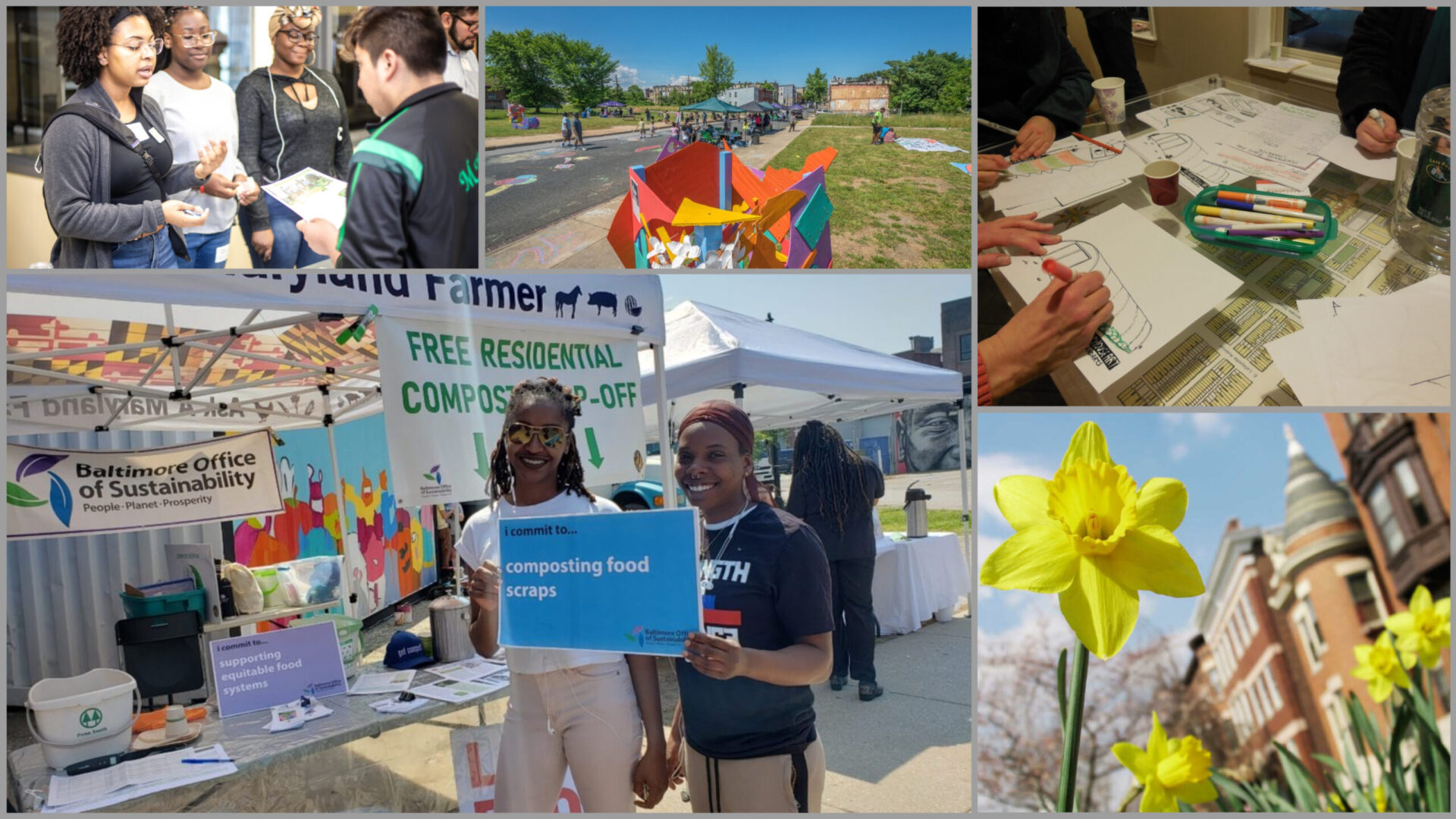The Baltimore Sustainability Plan is being updated! We are accepting public comments on the final draft of the plan from now through May 11, 2018. Everyone with a stake in Baltimore City is encouraged to participate, and all comments will be considered before the plan is finalized.
This page archives the original Baltimore Sustainability Plan, which was approved by the Baltimore City Council on March 2, 2009.
In 2006, the Baltimore City Planning department created a Comprehensive Master Plan designed to position Baltimore as a world-class city. Organized around four themes representative of life in Baltimore; Live, Earn, Play and Learn, the plan was designed to respond to opportunities for growth in Baltimore. The 2009 Baltimore Sustainability Plan was adopted as a portion of this plan, but was also designed to function as a plan of its own.
Overview
The 2009 Baltimore Sustainability Plan’s public engagement process, engaging over 1,000 citizens over an eight month period, gathered and analyzed ideas, studied best practices, and developed aspirations for a more sustainable city. The plan articulated 29 priority goals across seven core themes;
Cleanliness
Pollution Prevention
Resource Conservation
Greening
Transportation
Environmental Education and Awareness
Green Economy
Commission
To make decisions and take appropriate actions to guide the implementation of the sustainability plan, The Commission on Sustainability was created. Members represent environmental groups, community organizations, labor unions, public health and environmental justice interests, and private industry. Visit the Commission on Sustainability homepage for more information.
Goals
The 2009 Baltimore Sustainability Plan had 29 goals across seven core themes;
 Cleanliness
Cleanliness
-Eliminate litter throughout the city
-Sustain a clean and maintained appearance of public land
-Transform vacant lots from liabilities to assets that provide social and environmental benefits.
 Pollution Prevention
Pollution Prevention
-Reduce Baltimore’s greenhouse gas emissions by 15% by 2015
-Improve Baltimore’s air quality and eliminate Code Red days
-Ensure that Baltimore water bodies are fishable and swimmable
-Reduce Risks from hazardous materials
-Improve the health of indoor environments
 Resource Conservation
Resource Conservation
-Reduce Baltimore’s energy use by 15% by 2015
-Reduce Baltimore’s water use while supporting system maintenance
-Minimize the production of waste
-Maximize reuse and recycling of materials
 Greening
Greening
-Double Baltimore’s Tree Canopy by 2037
-Establish baltimore as a leader in sustainable, local food systems
-Provide safe, well-maintained public recreational space within 1/4 mile of all residents
-Protect Baltimore’s ecology and biodiversity
 Transportation
Transportation
-Improve public transit services
-Make Baltimore bicycle and pedestrian friendly
-Facilitate shared-vehicle usage
-Measure and improve the equity of transportation
-Increase transportation funding for sustainable modes of travel
 Education and Awareness
Education and Awareness
-Turn every school in Baltimore City into a green school
-Ensure all city youth have access to environmental stewardship programs and information
-Raise the environmental awareness of the Baltimore community
-Expand access to information on sustainability
 Green Economy
Green Economy
-Create green jobs and prepare city residents for these jobs
-Make Baltimore a center for green business
-Support local Baltimore businesses
-Raise Baltimore’s profile as a forward-thinking, green city
Accomplishments and Annual Reports
Key accomplishments that stemmed from the 2009 Baltimore Sustainability Plan include:
- Passing an Urban Agriculture Tax credit
- Adopting in 2010 the Baltimore City Green Building Standards and, in 2015, the International Green Construction Code
- Reducing residential gas use by 2.7 percent and electric use by 8.1 percent from the 2007 baseline by the Baltimore Energy Challenge
- Weatherizing more than 10,000 units inhabited by low-income families, collectively saving these families $10 million in reduced utility bills
- Training more than 820 residents for green construction careers, maintaining an 85 percent graduation rate and 87 percent job placement rate, with average wages of $13 to $18 per hour. The solar installation training program alone trained 55 residents, with an average wage placement of $15 per hour.
- Serving over 1 million pounds of local produce in 2015 in Baltimore City Public Schools, and using composting trays, instead of polystyrene, starting in June 2018.
- Reducing the cost of flood insurance by up to 25 percent for almost 2,000 properties
- Introducing One PLUS One recycling and trash collection program, citywide street sweeping, and citywide municipal trash cans
The Baltimore Office of Sustainability monitored progress made on the 2009 Plan goals and produced seven annual reports for the community. The reports served as a “check-in”, renewing our commitment, and celebrating our successes together as a community. As a community, we can hold ourselves accountable on a personal and collective level to future generations.
Links to the PDF’s of these reports can be accessed on the Annual Reports page.
Resources
Download the full 2009 plan in a PDF version.

